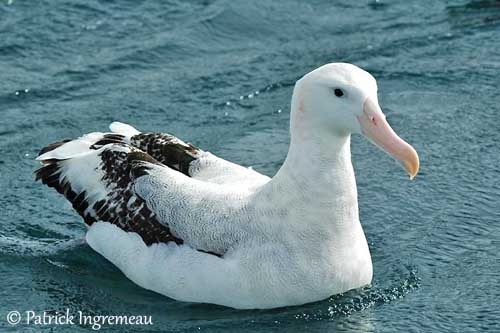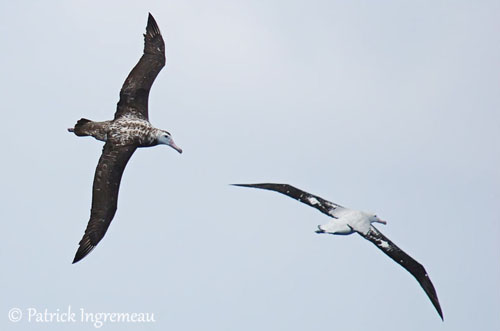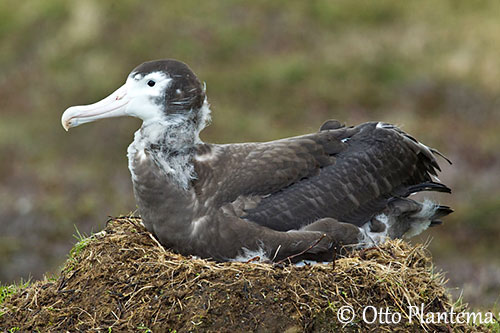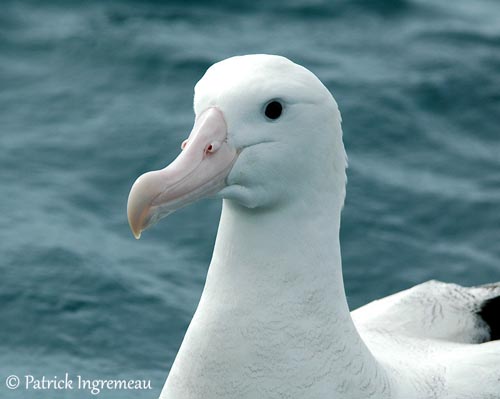
Fr: Albatros hurleur
All : Wanderalbatros
Esp : Albatros Viajero
Ital : Albatro urlatore
Nd: Grote Albatros
Sd: Vandringsalbatross
Port : Albatroz-gigante
Photographers:
Patrick Ingremeau
TAMANDUA
Tom Merigan
Tom Merigan’s Photo Galleries
Otto Plantema
Trips around the world
Text by Nicole Bouglouan
Sources:
HANDBOOK OF THE BIRDS OF THE WORLD vol 1 by Josep del Hoyo-Andrew Elliot-Jordi Sargatal - Lynx Edicions - ISBN: 8487334105
L’ENCYCLOPEDIE MONDIALE DES OISEAUX - Dr Christopher M. Perrins - BORDAS - ISBN: 2040185607
BirdLife International (BirdLife International)
Birds in backyards (Birds Australia and Australian Museum)
Wikipedia, the free encyclopaedia
Wandering Albatross
Diomedea exulans
Procellariiforme Order – Diomedeidae Family
INTRODUCTION:
With a wingspan of 350 cm, the Wandering Albatross has the largest wings of any living bird. Its weight ranges from 6300 to 11300 grams, and the immature can be larger while performing its first flight, as it still has fat reserves. This large size is more impressive when the bird is gliding easily above the waves.
Its other English names are Snowy Albatross and White-winged Albatross.
DESCRIPTION OF THE BIRD:
Biometrics:
Length: 107-135 cm
Wingspan: 254-351 cm
Weight: 6250-11300 g
The adult has snowy white plumage overall, except on the black-and-white wings. It becomes whiter with the age. Mantle and scapulars are white with very narrow blackish vermiculations extending to the upperwing-coverts.
The underparts are entirely white, but the underwing shows black tip and trailing edge.
There are variations, and some birds may have brownish-grey crown, whereas others have washed pale pink or pale orange ear-coverts.
The hooked bill is pink with pale yellowish tip. The eyes are dark brown. Legs and webbed feet are pale grey.

The female has similar plumage, but she may have weak greyish pectoral band. She usually shows less white on the upperwing, and her tail can be edged black. She is smaller than male.
The chick is covered with white down during several weeks, before to gain darker plumage.
The juvenile is dark brown with white face. Its plumage becomes progressively whiter.

SUBSPECIES AND RANGE:
D.e. exulans (here described) is found in Southern Ocean from South Georgia E to Antipodes islands.
D.e. dabbenema from Tristan da Cunha and Gough Island is now a full species named Tristan Albatross. It will be studied later.
HABITAT:
The Wandering Albatross is marine and highly pelagic. It comes to land only for breeding. It spends most of the time at sea, gliding above the waves. It occurs more often inshore in the Australasian part of the range.
This species breeds on remote islands. The nest is built on slopes, on exposed ridges or hillocks for easier take-off. The ground can be covered with scattered tussock grass.

CALLS AND SONGS: SOUNDS BY XENO-CANTO
Like other albatrosses, the Wandering Albatross produces several croaking, shrieking and gargling sounds, especially when feeding from fishing boats with other seabirds.
The displays are usually accompanied by cries, groans and moans. A very characteristic sound is produced by rapid bill-clappering.

BEHAVIOUR IN THE WILD:
The Wandering Albatross feeds on aquatic preys, mainly cephalopods, but also fish and some crustaceans. It takes carrion more often than other species.
The squid is caught at night close to the surface. Preys are caught by surface-seizing, but the Wandering Albatross may occasionally perform shallow plunges involving a short pursuit of the prey.
It feeds often among other Procellariiformes, and may sometimes follow cetaceans from which is gets scraps.
It sits on water only when the weather is calm and for feeding. It often follows fishing-boats for offal.

Mates pair usually for life. Courtship displays are those of other species, involving bill-circling, sky-pointing, spreading wings and mutual preening. Both mates can perform some dances with raised spread wings while calling.

The display called “ecstatic display” involves wing-stretching and bill-vibrating. The birds produce a braying whistle followed by an inhaled sigh, while the bill is pointing skywards.
This display reminds us that of Spheniscidae species.
They can breed at 10-11 years old. Copulation tales place on land, and often at nest. The pair only defends a small territory around the nest. Some fights may occur, but mainly when the birds are competing for food.

The Wandering Albatross usually disperses over the Southern Ocean after the breeding season, and most birds probably move E, maybe performing circumpolar movement.
They spend most of their life in flight, and may travel up to 500 km/day. The large wingspan allows them to glide easily on thermals. They rarely flap the wings and can fly effortless and continuously over long distances.

REPRODUCTION OF THIS SPECIES:
The breeding season starts in November, but the Wandering Albatross has biennial reproduction due to the long breeding cycle. This species breeds in loose colonies, usually in scattered groups of some nests.



The female lays a single creamy-white egg. Both adults incubate during 78 days, with stints of 2-3 weeks. The white downy chick is brooded during 4-5 weeks, and fed by regurgitation. It remains on the nest for about 9 months.


After fledging, it goes out at sea, and returns to the colony 5-6 years later, but it will start breeding only at 11-15 years old.
They are long-lived species, about 35-40 years and sometimes more.

PROTECTION / THREATS / STATUS:
The main threats for the Wandering Albatross come from the longline fleets. This species has wide foraging range and often encounters these dangerous fishing systems.
The chicks are threatened by accumulation of debris and fishing hooks which are swallowed by the young birds. Introduced cats and rats by sealers involve predation of young chicks at nest. In some parts of the range, and especially at South Georgia, habitat loss and degradation due to fur seal activities, have involved some population declines.
Currently, the Wandering Albatross is considered Vulnerable.

